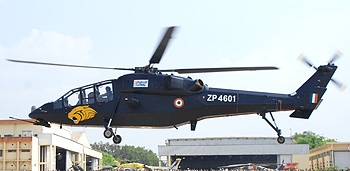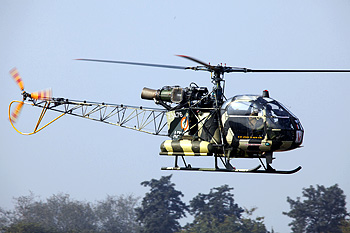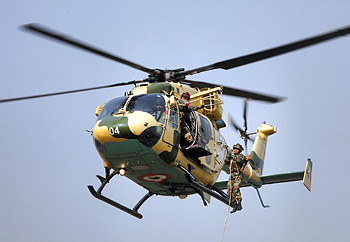INDIAN ARMED FORCES CHIEFS ON
OUR RELENTLESS AND FOCUSED PUBLISHING EFFORTS

SP Guide Publications puts forth a well compiled articulation of issues, pursuits and accomplishments of the Indian Army, over the years

I am confident that SP Guide Publications would continue to inform, inspire and influence.

My compliments to SP Guide Publications for informative and credible reportage on contemporary aerospace issues over the past six decades.
- Prime Minister witnesses 'Bharat Shakti' – a Tri-Services Firing and Manoeuvre Exercise in Pokhran, Rajasthan
- Interim Defence Budget 2024-25 — An Analysis
- Union Defence budget 2024
- Prime Minister Modi Commemorates Indian Navy Day in a Grand Ceremony
- Prime Minister Modi Flies in the LCA Tejas
- New Chapter in India-Italy Defence Ties
- Airpower beyond Boundaries
Attack Helicopters for Indian Army



All major armies of the world, including our adversaries China and Pakistan have full-fledged air wings of their own with all types of helicopters, including attack helicopters and fixed wing aircraft in their inventory. The Government in USA and UK had to intervene to facilitate the formation of a separate Army Aviation Corps, despite strong objections by their respective air force. During the Vietnam War (1945 - 1975), the US Army had more helicopters (rotor wing aircraft) than all of the branches combined (Air Force, Navy, Marines, Coast Guard). However, the Indian Army continues to be denied the rightful ownership of attack helicopters, despite the fact that this flying machine and weapon platform is acquired only for supporting ground forces in the battlefield. Stale arguments are put forward again and again to justify the unjustifiable.
Missions
The primary mission of Army Aviation is to fight the land battle and support ground operations. It operates in the tactical battle area (TBA) as a combined arms team expanding the ground commander’s battlefield in space and time. Its battlefield leverage is achieved through a combination of mobility and fire power, that is unprecedented in land warfare and hence it is the centrepiece of land force operations. Its greatest contribution to battlefield success is the fact that it gives the commander the ability to apply decisive combat power at critical times virtually anywhere on the battlefield. This may be in the form of direct fire from aviation manoeuvre units (attack/armed helicopters) or insertion of ground forces at the point of decision. This versatility is the essence of Army Aviation due to which it can be effectively employed right from commencement of offensive till conflict termination. The assets required for the above manoeuvre, the attack and assault helicopters, must be at the beck and call of a field force commander and also piloted by men in olive green who fully understand the ground situation, are from the same background and speak the same language. This will ensure the optimum utilisation of the battle winning resource.
Oft Repeated Arguments
In a recent article in The Times of India, Pune edition titled “The War Within: Army vs IAF in new turf battle”, the author has dwelt on the old and tedious arguments of the Air Force as to why Army should not have attack helicopters. Perhaps the author is not aware of the fact that this issue was first raised by the Army in 1963 and the so called turf war unfortunately continues to rage till date. I would like to highlight two issues raised in the article, purportedly the views of the Air Force. Firstly, the remark that Army does not have an aviation culture and therefore is not capable of operating and maintaining attack/heavy helicopters is not only shocking and condemnable but needs to be treated with utter disdain. The second issue pertains to the reference to the Joint Army-Air Instruction of 1986, which supposedly permits the Army to only operate helicopters of less than five tonne weight. In the light of the above, there is a need to highlight a few facts to de-mystify the deliberate attempt to create a haze.
Army Aviation Corps (AAC) Perspective Plans
The AAC is a thoroughly professional force and has an aviation culture as good as or even better than the Air Force. It operates the largest fleet of helicopters in India (Cheetah, Chetak and advanced light helicopter (ALH)) to the extreme limits of man, machine and terrain. It is the lifeline of troops deployed in Siachen. The AAC already has in its inventory the lancer gunship (armed Cheetah) complete with a sighting system, gun and rockets and has been bloodied in operations in counter-insurgency environment. The armed version of the ALH (Rudra) is purely an Army project and is being inducted into the AAC by the end of this year. In addition to the gun and rockets, the Rudra has air-to-air and air-to-ground missiles, akin to any state-of-the-art attack helicopter in service today. In fact, the light combat helicopter (LCH) being developed by HAL will have the same weapon complement as the Rudra. As per the AAC Perspective Plans (future plans), the Rudra units will form part of the Pivot/Holding Corps and will play a crucial role in any future conflict. It would be pertinent to mention here that the Army Aviation test pilots and flight test engineers were totally involved in the selection and integration process of all the weapon systems in the Rudra project. This should put aside any fears/apprehensions regarding the capabilities of the Army to operate and maintain armed/attack helicopters that my colleagues in IAF may have.
With regards to the second issue, both the ALH and Rudra are above the five tonne category. Hence the repeated reference to this issue defies logic. Secondly, today the entire threat perception and security environment has undergone a drastic change since 1986. Indian Army faces a two front threat and anticipates hybrid nature of operations in the future and has embarked on the road to modernisation and transformation to keep pace with the emerging threats and challenges. The other two services also a part of this process and their acquisition plans speak for themselves. The Air Force needs to focus more on its strategic role and leave the TBA for the Army to handle, keeping in mind the nature of future conflicts. There is a tacit need for the Air Force to have a re-look at the 1986 document and move away from a rigid mindset.
Enhance the Overall Goal and Capability of the Land Forces
The role that Army Aviation needs to perform in support of land battle requires equipment, personnel, air crew and organisations enhancing the overall goal and capability of the land forces commander. The need is for dedicated air crew who are not only proficient in flying but are associated full time with Army manoeuvres, operational thinking and ground tactics, as well as time spend in the field. The present structure is not suited for the short, swift and limited wars envisaged in the future.
Turf battles are part of every nations defence forces, but experience of other nations clearly illustrates that each service needs a viable integral aviation component for it to retain the capacity to meet future challenges on the ground by using aerial manoeuvre and attack as part of its response to the dynamics of an ever changing battlefield. The control and ownership of attack helicopters and medium-/heavy-lift helicopters by the Army is an operational imperative due to the need for integration of all elements of Army Aviation (combat and combat support) into a cohesive combat organisation.
The time for decision is now.





